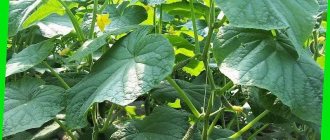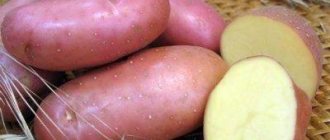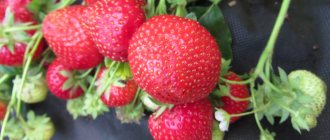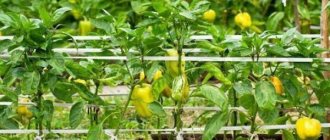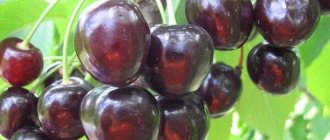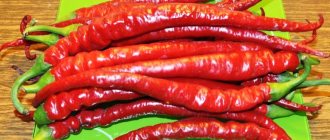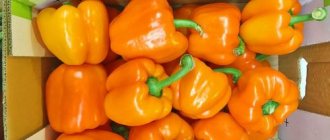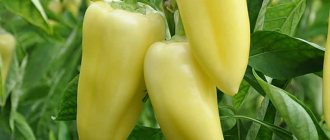Description of Pompeo pepper
Initially, the Pompeo F1 sweet pepper variety was recommended for commercial production in open ground in the Lower Volga and North Caucasus regions. However, its characteristics, as well as taste and commercial qualities, quickly fell to the taste of the owners of private farms. Today, Pompeo pepper varieties are cultivated in greenhouse conditions in the Central and Northwestern regions of the Russian Federation. There are craftsmen who obtain more stable harvests in the Urals and in the difficult climatic conditions of Western Siberia.
Pepper variety Pompeo F1, the characteristics and description of which are given in the article, forms powerful medium-spreading bushes 70-90 cm high. The stem and main shoots are dark green. Often with a burgundy or purple tint. Plants are densely leafy. The leaves are large, ellipsoidal in shape. The leaf blades are slightly wrinkled, rich green in color with a slight glossy sheen.
Pepper blooms with white and lilac flowers with funnel-shaped flowers. Flowers are single or collected in groups of 2-3 pieces in each inflorescence. The fruits of sweet peppers of the Pompeo variety (judging by the photos and reviews of gardeners) are cubic or truncated cone-shaped with pronounced ribbing. Up to 6-10 fruits can form on one bush at the same time. A distinctive feature is the long and thick stalk, which allows you to pick vegetables without damaging them.
Interesting fact!
Pepper Pompeo F1 and the Dutch hybrids Gemini, Rubine, and Senator are very similar in characteristics. The first variety of pepper is distinguished by the bright yellow color of its fruits. Rubine and Senator - a more pronounced cone-shaped shape and early ripening. Their first fruits can be obtained within three months after germination.
The average weight of Pompeo F1 pepper is 150-250 grams. It forms 3-4 chambers with seeds and is distinguished by dense and juicy walls, or, as experts call them, pericarps with a thickness of 5 to 10 mm. At the stage of technical maturity, the fruits are dark green or brown-green. As the skin ripens, it acquires a rich scarlet color and a glossy sheen.
Description of fruits and characteristics of the variety
According to the description of the variety, Pompeo pepper forms a powerful bush 90-110 cm high. The tops are large, wrinkled, dark green in color. The leaves are petiolate, solitary, of simple type. The flowers are large, axillary, white, with a purple corolla. The stems are powerful and dense.
Characteristics of the fruits of the Pompeo variety:
- cylindrical shape;
- length 12-13 cm;
- diameter 8-9 cm;
- wall thickness up to 1 cm;
- glossy surface;
- green color, changes to red as it ripens;
- number of nests from 3 to 4;
- thick and long stalk.
The ripening period for bell peppers is 95-110 days after germination. Ripe fruits are easily removed from the bush.
Pompeo is prized for its good taste, which is preserved when canned. The fruits are used fresh for salads and snacks. Good taste is not lost after heat treatment. For the winter, peppers are pickled or added to assorted vegetables.
With good care, the weight of the fruit reaches 450 g. The peculiarity of the variety is the high content of ascorbic acid in the pulp. The crop retains its commercial properties and density during storage for a long time. Even overripe fruits are not subject to rotting.
Characteristics of Pompeo sweet pepper
According to reviews from vegetable growers, the Pompeo F1 sweet pepper variety is characterized by relative cold resistance and drought resistance. It will not tolerate late return frosts, but short-term cold snaps will not affect the yield. However, so does moisture deficiency. But there is no point in experimenting. It is better to provide the plant with timely watering. Especially during the fruiting period. The Pompeo F1 variety is mid-season. It reaches technical maturity 100-110 days after the seeds hatch. To obtain fruits at the stage of biological maturity, you need to wait another 7-10 days. Fruiting continues for 1-1.5 months. In warm autumn conditions, when growing vegetables in a greenhouse, the second wave of flowering begins in September.
The productivity of Pompeo F1 pepper is high. Depending on the growing conditions, from 1 m² you can get from 20 to 25 kg of fruit per season. The variety bears fruit best in sunny areas, protected from the wind, with loose and fertile soils. Timely watering and fertilizing play an important role.
Pompeo F1 pepper has high commercial characteristics. Its fruits can ripen in a dark, cool room. In the cold, the pods can be stored for up to 1 month without signs of wilting or loss of taste. Fruits with thick and dense walls tolerate transportation well over long distances.
Features of growing seedlings
It is recommended to plant Pompeo seedlings from February 20 to March 1. By the time of transplantation to a permanent place, the age of the seedlings should be 65-75 days. The soil mixture for seedlings should consist of the following components:
- peat – 35%;
- soil from the garden (but not from tomatoes) steamed to +60°C – 30%;
- store-bought soil with microelements and fertilizers – 20%;
- purchased vermicompost – 10%;
- perlite – 4%;
- vermiculite – 1%.
Seedlings are grown either in common boxes or in separate seedling cups. The first option is most often used, which implies mandatory picking. In this case, containers with a wall height of about 10 cm are used. The bottom is covered with a 2-centimeter layer of charcoal, which performs a drainage function. Soil 7 cm high is poured on top.
The soil is spilled from a spray bottle with water with nutrients dissolved in it. Rows are drawn on the surface at a distance of 6 cm from each other, into which Pompeo pepper seeds are placed every 4-5 cm. The plantings are irrigated again with a spray bottle and sprinkled with dry soil on top. The plantings are covered with film and placed in a room with an air temperature of +30°C.
After 5-6 days, seedlings begin to appear, and the shelter is removed. The temperature is reduced to +22...25°C during the day and +16...18°C at night. Containers with seedlings are moved to a well-lit place, because Pompeo requires 11-12 hours of daylight.
It is necessary to constantly monitor soil moisture and maintain it at an optimal level, avoiding waterlogging and drying out. If you add too much moisture, there is a risk of developing fungal diseases and dropping leaves.
2-3 weeks before transplanting, seedlings begin to be prepared for this by hardening. Containers with seedlings begin to be taken outside. At first, the duration of the plants’ stay in the fresh air should be minimal, but it increases every day. It is worth making sure that Pompeo seedlings are not exposed to a draft.
Landing rules
Pompeo F1 pepper in the middle zone is grown by seedlings, which allows you to get a harvest in mid-July.
Planting seedlings
To obtain seedlings by the second ten days of May, Pompeo F1 pepper seeds are planted in late February or early March. The soil is first prepared from equal parts of garden soil, humus and sand. You can also use purchased universal soil with neutral acidity.
Attention!
Pompeo F1 pepper seeds do not require additional treatment with disinfectants. The seed of hybrid varieties is processed at the seed production stage.
Sowing is done in containers filled with moist soil. The seeds are laid out on the surface in rows. Lightly press and mulch with a layer of soil 0.5-1.0 cm high. The plantings are moistened with a spray bottle. The containers are covered with glass or film and left to germinate.
Growing seedlings
With the emergence of seedlings, the boxes are moved to a well-lit place. Provide plants with timely watering, fertilizing with complex fertilizers, and additional lighting as needed. At the stage of 2-4 true leaves, picking is carried out in separate containers.
Transplantation into the ground
In the middle zone, seedlings of Popmeo F1 pepper are transplanted into greenhouses in mid-May, and into open ground - towards the end of the month. Focus on weather conditions. It is important that the threat of return night frosts passes. Despite its cold resistance, pepper cannot withstand negative air temperatures.
The soil is dug up in advance, adding compost. The holes are being prepared. Before planting, humus and potassium-phosphorus fertilizers are added to them. On acidic soils, it may be necessary to add wood ash or dolomite flour. On heavy ones - sand or vermiculite.
Advantages and disadvantages
Pros:
- tolerance to dry periods;
- long-term storage in cool rooms;
- marketability and transportability;
- strong immunity to infections;
- endurance to adverse factors;
- significant productivity;
- wonderful taste;
- Wide culinary use.
Minuses:
- needs additional lighting at the seedling stage;
- stable heat is maintained for seedlings;
- impossibility of harvesting your own seeds (already in the second generation, 25% of the quality of the hybrid is lost).
Rules of care
During the season Pompeo F1 pepper:
- water moderately, increasing the volume of liquid during the period of active fruiting;
- fed with organic and complex fertilizers;
- weed and loosen the ridges.
There is nothing difficult about growing Pompeo F1 peppers. Even absolute beginners in the field of vegetable growing can cope with cultivating this unpretentious variety.
Features of agricultural technology
Pompeo F1 pepper is planted as seedlings in the beds. The seeds are not pre-treated, but are germinated. Other agrotechnical recommendations:
- when planting 60-day-old seedlings, the soil temperature should be 15 - 18 degrees;
- the soil under the bushes should be enriched with potassium fertilizers;
- during the first week after planting the seedlings in the garden bed, you need to provide them with shade;
- Pepper should be watered once every 3 days;
- when loosening, the tool is not immersed more than 7 cm;
- it is necessary to feed the crop 3 times per season;
- On the bushes, remove foliage and shoots below the first fork, as well as leaves that prevent the ripening of fruits.
Sowing seeds for seedlings | Planting seedlings in a greenhouse/greenhouse | Planting seedlings in exhaust gas | Stepsoning | Harvesting |
| End of February | May | The beginning of June | Removing branches up to the first fork, excess foliage, weak shoots | Early August - October |
| *dates are indicated for central Russia | ||||
Diseases and pests
Breeders claim that Pompeo F1 pepper has a high degree of resistance to blossom end rot, as well as tobacco mosaic and spotted wilt viruses. In cool and damp years, it may rarely be affected by powdery mildew or late blight. As a preventative measure, at the end of July, plants can be treated with a solution of Fitosporin.
Pests, according to vegetable growers, also rarely show interest in peppers of this variety.
You can learn more about the Pompeo F1 pepper from the video
Reviews from gardeners about sweet pepper Pompeo F1
Olga, 40 years old, Stavropol My husband and I have a small farm. He also deals with sweet peppers. We have been planting Pompeo F1 for several years now. Excellent variety. Ripens in open ground. Not afraid of heat and drought. Productivity reaches 35 kg per square. It bears fruit for a very long time and abundantly.
Svetlana, 35 years old, Orel Peretz Pompeo F1 performed well in our latitudes. To be honest, I didn’t even know that it was for the south. This is not the first year I have been growing it in a greenhouse. Never let me down. During the fruiting period, the bushes are strewn with bright peppers. The taste is wonderful. Sweet. But there is also a slight sourness. Pepper fruits are medium in size. Just right for stuffing.
